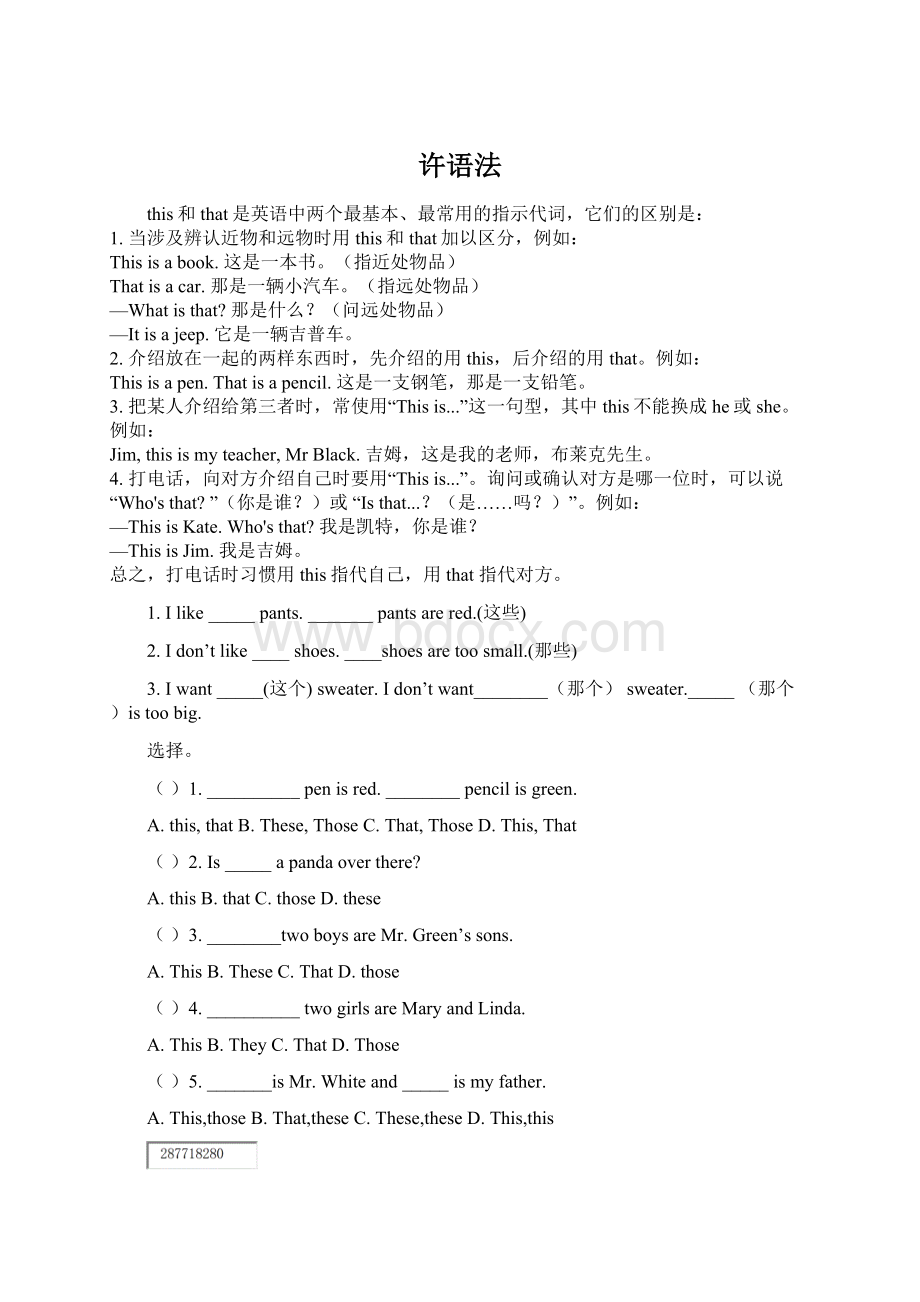许语法.docx
《许语法.docx》由会员分享,可在线阅读,更多相关《许语法.docx(14页珍藏版)》请在冰豆网上搜索。

许语法
this和that是英语中两个最基本、最常用的指示代词,它们的区别是:
1.当涉及辨认近物和远物时用this和that加以区分,例如:
Thisisabook.这是一本书。
(指近处物品)
Thatisacar.那是一辆小汽车。
(指远处物品)
—Whatisthat?
那是什么?
(问远处物品)
—Itisajeep.它是一辆吉普车。
2.介绍放在一起的两样东西时,先介绍的用this,后介绍的用that。
例如:
Thisisapen.Thatisapencil.这是一支钢笔,那是一支铅笔。
3.把某人介绍给第三者时,常使用“Thisis...”这一句型,其中this不能换成he或she。
例如:
Jim,thisismyteacher,MrBlack.吉姆,这是我的老师,布莱克先生。
4.打电话,向对方介绍自己时要用“Thisis...”。
询问或确认对方是哪一位时,可以说“Who'sthat?
”(你是谁?
)或“Isthat...?
(是……吗?
)”。
例如:
—ThisisKate.Who'sthat?
我是凯特,你是谁?
—ThisisJim.我是吉姆。
总之,打电话时习惯用this指代自己,用that指代对方。
1.Ilike_____pants._______pantsarered.(这些)
2.Idon’tlike____shoes.____shoesaretoosmall.(那些)
3.Iwant_____(这个)sweater.Idon’twant________(那个)sweater._____(那个)istoobig.
选择。
()1.__________penisred.________pencilisgreen.
A.this,thatB.These,ThoseC.That,ThoseD.This,That
()2.Is_____apandaoverthere?
A.thisB.thatC.thoseD.these
()3.________twoboysareMr.Green’ssons.
A.ThisB.TheseC.ThatD.those
()4.__________twogirlsareMaryandLinda.
A.ThisB.TheyC.ThatD.Those
()5._______isMr.Whiteand_____ismyfather.
A.This,thoseB.That,theseC.These,theseD.This,this
1theseThese
2thoseThose
3thisthatthat
1D2B3B4D5D
名词单数变复数口诀
(一) 规则变化
名词单数变复数,直接加-s占多数;
s,x,z, ch, sh来结尾,直接加上-es;
词尾是f或fe,加-s之前先变ve;
辅母+y在词尾,把y变i再加-es;
词尾字母若是o,常用三个已足够,
要加-es请记好,hero, tomato, potato。
(二) 不规则变化
男人女人a变e,鹅足牙oo变ee;
老鼠虱婆也好记,ous变ic;
孩子加上ren,鱼鹿绵羊不用变。
1. 英语名词有单数和复数的区别,单数表示“一”,复数表示“多于一。
”名词由单数变复数,多数是规则的变,直接加-s,例如:
book→books, girl→girls。
但以-s, -z, -x, -ch, -sh结尾的名词,变成复数时加-es,例如:
bus→buses, buzz→buzzes, box→boxes, watch→watches, brush→brushes
2.-f(e)结尾的名词单数变复数歌诀:
① 树叶半数自已黄,妻子拿刀去割粮,架后窜出一只狼,就像强盗逃命忙。
② 妻子持刀去宰狼,小偷吓得发了慌,躲在架后保己命,半片树叶遮目光。
例如:
leaf(树叶,叶子),half(一半),self(自已),wife(妻子),knife(刀子),shelf(架子),wolf(狼), thief(窃贼,强盗) 和life(生命),这些名词变成复数时,都要改-f(e)为v,再加-es。
3.-f 结尾的名词直接加-s变复数歌诀:
海湾边、屋顶上,首领奴仆两相望;谁说他们无信仰,证据写在手帕上。
例如:
gulf,roof,chief,serf,belief,proof,handkerchief,这些名词变复数直接加-s。
注:
scarf(围巾;披风) 可以先改f为ve再加-s,也可直接加-s。
4.辅音字母+y结尾的名词,把y变i加-es。
例如:
baby→babies, country→countries, family→families;而-y前是元音时,-y不变,直接加-s。
例如:
day→days, boy→boys
5.以-o结尾的名词变复数时,多数直接加-s。
例如:
radio→radios, piano→pianos, kangaroo→kangaroos;有的须加-es,中学课本中有几个这样的单词,可以通过一句口诀来记忆:
黑人英雄爱吃西红柿和土豆。
即:
Negro→Negroes, hero→heroes, tomato→tomatoes, potato→potatoes;有的以o结尾的名词既可加-s也可加-es。
例如:
volcano(火山)→volcanos/volcanoes等。
6.名词复数的不规则变化需要特别记忆。
例如:
man→men, woman→women, goose→geese, foot→feet, tooth→teeth, mouse→mice, louse(虱子)→lice, child→children,fish→fish,deer(鹿)→deer, sheep→sheep等。
7.初中课本中表示“某国人”的名词复数形式变化可通过歌诀记忆:
中日不变英法变,其余-s加后面。
例如:
Chinese→Chinese, Japanese→Japanese;Englishman→Englishmen,Englishwoman→Englishwomen, Frenchman→Frenchmen, Frenchwoman→Frenchwomen;American→Americans, Rusian→Rusians, Arab→Arabs, German→Germans等。
8.不可数名词一般只有单数形式,没有复数形式。
有些不可数名词可借助单位词表示一定的数量。
例如:
a cup of tea一杯茶, two pieces of paper两张纸, an item of news一则新闻
名词单数变复数的读音变化
一般情况加-s 清辅音后读/s/ map-maps
浊辅音和元音后读/z/ bag-bags/car-cars
以s,sh,ch,x等结尾 加-es 读/iz/ bus-buses/watch-watches
以ce,se,ze,等结尾 加-s 读/iz/ license-licenses
以辅音字母+y结尾 变y为i再加es 读/z/baby---babies
现在进行时
一、概念
现在进行时表示说话时正在进行或发生的动作,也可表示当前一段时间内的活动或现阶段正在进行的动作.
结构:
助动词be(am/is/are)+现在分词.
二、现在分词的构成:
1.大多数动词后可在动词后直接加-ing.
Eg:
carry-carrying,catch-catching,drink-drinking,enjoy-enjoyinghurry-hurrying,do-doing,read-reading,think-thinking
2.如果动词以-e结尾,则去掉-e,再加-ing,
如come-coming,have-having,make-making,ride-riding,write-writing,take-taking,use-using.
3.如果动词只有一个元音字母,而其后跟有一个辅音字母时,将此辅音字母双写,再加-ing
如:
hit-hitting,let-letting,put-putting,run-running,sit-sitting.
4.如果动词有两个音节,且重音在第二个音节上,则末尾的辅音字母须双写,再加-ing,
如:
for’get-forgetting,pre’fer-preferring,up’set-upsetting.试比较’benefit/benfiting,’differ/differing,’profit/profiting,这些词的重音在第一个音节上,因此其末尾的辅音字母不双写.
5.以-ic结尾的动词,应先把-ic变为-ick,再加-ing,eg:
panic/panicking,picnic/picnicking,但lie/lying,die/dying,tie/tying是特殊变化要记住.
三、句型结构:
1.现在进行时的肯定形式、否定形式、疑问形式及其回答,所有变化都体现在助动词be(is/am/are)上.
1)现在进行时的肯定形式:
主语+be(am/is/are)+doing+其他成分
Iamsinging.Theyarewriting.
2)现在进行时的否定形式:
主语+be(am/is/are)+not+doing+其他成分
Iamnotsinging.Theyaren’twriting.
3)一般疑问句及回答:
be(am/is/are)+主语+doing+其他成分
AmIsinging?
Yes,youare./No,youaren’t.
Aretheywriting?
Yes,theyare./No,theyaren’t.
4)特殊疑问句及回答:
特殊疑问词+be(am/is/are)+主语+doing+其他成分
Whatareyoudoing?
Weareplaying(要求就提问内容具体回答).
2.缩写形式如下:
Iam---I’mYouare---You’reHeis---He’sSheis---She’s
Itis---It’sWeare---We’reTheyare---They’re
3.说明:
不是所有动词都能用现在进行时态的,如:
see、like、want、know等动词往往都不用进行时态.
四.用法:
1.表示现在(指说话人说话时)正在发生的事情.往往与now,atthemoment,just等副词连用,以示强调.
Wearewaitingforyou.Whatareyoudoing?
Someone’sknockingatthedoor.
2.正在进行着的动作可视为未完成的动作:
He’stalkingtohisfriendsintheclassroom.
可用still一词强调动作的持续性
He’sstilltalkingtohisfriendsintheclassroom.
3.表示长期的或重复性的动作,说话时动作未必正在进行.
Mr.Blackiswritinganotherarticle.
Don’ttakethatbookaway.Yourfather’susingit.
SheislearningpianounderMr.Black.
4.现在进行时可用来表示不会长期发生的动作或情况,或被认为在短期内正在进行的动作或存在的情况:
What’syourbrotherdoingthesedays?
He’sstudyingEnglishatOxfordUniversity.
5.现在进行时也可以用来表示当前的动向:
Peoplearebecomingmoreandmorebeautifulthesedays.
6.表示渐变的动词有:
become,turn,get,grow,run,go,begin等.
Theleavesareturningbrown.
It’sgettingcolderandcolder.
7.与always,constantly,forever等词连用,表示反复发生的动作或持续存在的状态,往往带有说话人的主观色彩.
Youarealwayschangingyourmind.
8.现在进行时(以及begoingto)可以表示为将来安排好的活动和事件We’respendingnextwinterinChina.用arrive,come,go,leave等动词的现在进行时描写行程安排,也通常有“将到达”和“将离去”的意思:
He’sarrivingtomorrowmorning.
9.当现在进行时表示某事发生的次数过多时,则有时含有抱怨,讨厌,赞扬等的意思:
Heisalwayssingingatnight,andwecan’tfallasleeplateatnight.
练习
一.用现在进行时完成下列句子:
1.______you__________(fly)akite?
Yes,_______.
2.______you___________(sit)intheboat?
3.______he_____________(talk)withme?
4.We_______________(play)footballnow.
5.What_________you__________(do)?
6.I_____________(sing)anEnglishsong.
7.What________he____________(mend)?
8.He______________(mend)acar.
9.Theseboys_________(play)tennisontheplayground.
10.Mymother______________(cook)inthekitchen.
11.Wecan’thelpyou,becausewe____________(have)classes.
12.________theboy___________(write)hishomework?
13.Look!
Thesebutterflies_________(fly)inthesky.
14.Listen!
Thegirl___________(sing)inthenextroom.
15.Thenaughtyboy__________(swim)intheriver.
二.选择
1.Look.Lucyis_____anewbiketoday.
A.jumping B.running C.riding Dtakeing
2.Thechildren_____football.
A.isplaying B.areplaying C.playthe D.playa
3.They______TVintheevening.Theydotheirhomework.
A.arewatching B.can’twatching C.don’twatch D.don’twatching
4.Listen!
She____intheclassroom.
A.issinging B.sing C.tosing D.issing
5.______areyoueating?
I’meating______meat.
A.What,some B.Which,any C.Where,not D.What,a
6.Isshe____something?
A.eat B.eating C.eatting D.eats
7.Mydictionary___,Ihavelookedforiteverywherebutstill___it.
A.haslost,don’tfind B.ismissing,don’tfind C.haslost,haven’tfound D.ismissing,haven’tfound.
8..Havingacomputerforpersonaluseisnoeasytaskbecausetechnology_______sorapidly.
A.ischanging B.haschanged C.willhavechanged D.willchange
9.Thebuilding_______,Ican’tstandthenoise.
A.wasbeingbuilt B.isbuilt C.isbeingbuilt D.builds
10.Ican’tcatchupwiththefashion,becausetheclothesstyle_______allthetime.
A.haschanged B.ischanged C.ischanging D.changed
11.It’ssixintheafternoon.TheGreens_______lunchtogether.
A.has B.arehaving C.havehad D.hadhad
12.Don’tmakeanynoisewhilethestudents_______totheclass.
A.arelistening B.listened C.havelistened D.hadlistened
13.JackandKetty_______inthelake.Let’sjointhem,shallwe?
A.swim B.haveswum C.swam D.areswimming
14.Look!
Thechildren_______basketballontheplayground.
A.plays B.played C.isplaying D.areplaying
15.Thekite_______highintheskynow.Itlookslikeabigbird.
A.hasflown B.isflying C.wasflying D.flew
16.Asweallknow,thepopulationintheworld_______fasterandfaster.
A.isgrown B.isgrowing C.aregrown D.aregrowing
17.Tomysurprise,he_______inclass.
A.isalwaysspeaking B.wouldalwaysspeak C.hasalwaysbeenspeaking D.doesspeakalways
18.Iwanttoknowwhenhe_______forNewYorktomorrow.
A.hasleft B.isleaving C.hadleft D.hasbeenleaving
19.He_______ofhowhecandomoreforthepeople.
A.hadalwaysthought B.isalwaysthinking C.hasalwaysbeenthought D.thinkingalways
20.Forests_______andburnedatsuchaspeedthattheywilldisappearfromtheearthinthefuture.
A.cut B.arecut C.arebeingcut D.hadbeencut
1.Are,flying,Iam 2.Aresitting, 3.Is,talking 4.areplying 5.are,doing 6.amsinging 7.is,mending 8.ismending 9.areplying 10.iscooking 11.arehaving 12.Is,writing 13.areflying 14.issinging, 15.isswimming
1.C 2.B 3.C 4.A 5.A 6.B 7.D 8.A 9C 10.C 11.B 12.A 13.D 14.D 15.B 16.B 17.A 18.B19.B 20.C
主格
宾格
形容词性
物主代词
名词性
物主代词
反身代词
第一
人称
单数
I
(我)
me
my
(我的)
mine
myself
(我自己)
复数
we
(我们)
us
our
(我们的)
ours
ourselves
(我们自己)
第二
人称
单数
you
(你)
you
your
(你的)
y